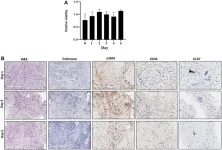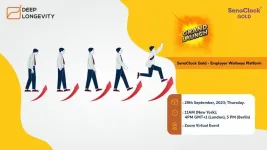(Press-News.org) Barcelona, Spain: Two out of the four internationally-recommended screening tools used by emergency medical services are inadequate for recognising sepsis, according to new research presented at the European Emergency Medicine Congress today (Wednesday).
Mrs Silke Piedmont, a health scientist at the Department of Emergency Medicine Campus Benjamin Franklin Charité – Universitätsmedizin Berlin (Germany), and her colleagues from the University of Magdeburg and Jena (Germany), analysed data on 221,429 patients who were seen by emergency medical services (EMS) in Germany in 2016 outside of the hospital setting. They found that only one out of four screening tools had a reasonably accurate prediction rate for sepsis – NEWS-2 (National Early Warning Score). It was able to correctly predict 72.2% of all sepsis cases and correctly identified 81.4% of negative, non-septic, cases.
A second screening tool, qSOFA (quick Sequential Organ Failure Assessment), correctly predicted 96.6% of patients who did not have sepsis.
Mrs Piedmont said: “We found that paramedics never documented a suspicion of sepsis, and emergency services physicians rarely did so, only documenting a suspicion in 0.1% of cases. The screening tools recommended in the Surviving Sepsis Campaign guidelines differed greatly in terms of which and how many patients were identified as possibly having sepsis.”
Sepsis, often referred to as blood poisoning, is a life-threatening condition that arises when the body’s immune system goes into overdrive in response to an infection and injures the body’s tissues and organs. It is vital to recognise it early, otherwise it can lead to shock, multiple organ failure and even death.
Speaking before the Congress, her colleague Dr Wolfgang Bauer, senior physician at the Charité, said: “In emergency care, there are good and long-established standards for the detection and treatment of heart attacks and stroke that have improved patients’ chances of survival. Unfortunately, a lot less attention is paid to sepsis and standards to improve early sepsis recognition and survival. Our study found there was a similar incidence for sepsis, 1.6%, as for heart attacks, 2.6%, and stroke, 2.7%, in cases seen by emergency medical services. However, in terms of both percentages and absolute numbers, more patients died from sepsis than from heart attacks or stroke. Out of all cases with sepsis, 31.4% died within 30 days after being seen by emergency services, versus 13.4% and 11.8% respectively for heart attacks and stroke. These findings emphasise the need for better sepsis awareness and more frequent use of effective screening tools.”
Mrs Piedmont and colleagues say the Surviving Sepsis Campaign guidelines about which sepsis screening tool is the most reliable for use by EMS are not specific enough and are based on little, useful evidence. The aim of the current study was to assess which of four screening tools was best for EMS to predict sepsis – NEWS-2, MEWS (Modified Early Warning Score), SIRS (Systemic Inflammatory Response Syndrome) or qSOFA.
The study linked data on 221,429 cases with follow-up between 2016 and 2017 from ten health insurance companies with information from documentation by paramedics and emergency doctors on 110,419 cases in 2016. This enabled the researchers to calculate the four screening tools’ ability to predict that a patient had sepsis. The predictions were confirmed or rejected during subsequent hospital investigations after contact with EMS. The researchers also looked at incidence and death rates for sepsis compared to heart attack and stroke, how much was recorded about any suspicions of sepsis, and how often EMS staff would have documented sepsis if they had used screening tools.
When they compared the performance of the four screening tools, the researchers found that NEWS-2 was the best for identifying patients with sepsis as it had a sensitivity (correctly predicted sepsis) of 72.2%, followed by MEWS, which had a sensitivity of 46.8% and a specificity (correctly predicted no sepsis) of 88.4%, SIRS (30.4% sensitivity, 93.8% specificity), and qSOFA (24% sensitivity, 96.6% specificity). Out of all EMS cases, 24.3% of cases were predicted to have sepsis by at least one of the screening tools, but only 0.9% were predicted to have sepsis by all four tools simultaneously.
“The incidence and death rates for sepsis and the low recognition of it, emphasise the need for better awareness and more frequent use of screening tools,” said Mrs Piedmont. “No screening tool provides ideal performance. NEWS-2 best supports emergency medical services in identifying most patients with sepsis. EMS patients that are NEWS-2 positive should be flagged up as potentially having sepsis and referred for special attention and assessment by emergency doctors who are expert in sepsis. If EMS insist on using the qSOFA, they should be aware that a positive qSOFA makes sepsis likely, but also, that a negative qSOFA cannot rule out sepsis conclusively.
“A rule of thumb for EMS staff could be that NEWS-2 negative patients are the most likely not to have sepsis, and qSOFA positive patients are the most likely to have sepsis – and also that qSOFA misses many patients with sepsis. Further clinical patient assessment and evaluation will always be needed for both tools. Future sepsis guidelines should be more precise and omit recommendations for MEWS and SIRS for emergency medical services since they were inferior in all the measures for accuracy.”
The researchers say these findings could also apply to other countries, especially as studies in Canada and the UK support aspects of their results [2,3]. “Ours is the first study comparing all four screening tools and showing the predictive usefulness of applying the screening tools to all adult patients independently of any presumptions or preliminary diagnoses by emergency medical services,” said Mrs Piedmont.
There were two things that could be improved, say the researchers: better and complete assessments of vital signs, such as body temperature and breathing rate; and “translating” alarming vital signs into a suspicion of sepsis, which could be helped by using a good sepsis screening tool.
“Sepsis causes approximately 20% of all global deaths,” said Mrs Piedmont [4]. “There is great potential to save lives and maintain patients’ quality of life if sepsis is recognised and treated earlier. As most sepsis cases start outside of hospital, emergency medical services play a vital role. They can shorten the length of time until sepsis treatments can be provided quickly in hospitals and reduce the risk of dying if they suspect sepsis.
“In addition, it’s crucial that the public’s awareness of sepsis is increased, by integrating it into education systems and through media campaigns. Patients ought to know the variety of sepsis symptoms, how urgent it is to call for prompt help and to ask the question ‘Could it be sepsis?’. As sepsis prevention is even better than early detection, they should also be aware of preventive measures such as hygiene and vaccination.”
The researchers hope their findings will inform new guidelines on sepsis that are being drawn up in some countries so as to give more specific recommendations for sepsis screening. More research is also needed to improve screening tools and to assess the real-world effects of screening tools on patients with and without sepsis.
Professor Youri Yordanov from the St Antoine Hospital emergency department (APHP Paris), France, is Chair of the EUSEM 2023 abstract committee and was not involved in the research. He said: “Sadly, we too often see patients being brought into hospital emergency departments with advanced sepsis. Some of them we can save, but unfortunately some will die who could have been saved if they had received treatment at an earlier stage. Emergency services need tools that can help them quickly and accurately predict that a patient may have sepsis and should be investigated further in hospital. This study shows that more needs to be done to develop such tools and improve the existing ones. Only then will we be able to bring down the death rates from sepsis.”
(ends)
[1] Abstract no: OA97, “Sepsis screening by Emergency Medical Services - Why recommendations of the Surviving Sepsis Campaign are too unspecific. Results from a cohort study,” by Silke Piedmont, in the oral abstract session “Pre-hospital and EMS”, 10.35-12.00 hrs CEST, Wednesday 20 September in the VIP room. https://cm.eusem.org/cmPortal/Searchable/EXA/config/normal/redirectconfig/normal/redirectconference/EUSEM23#!sessiondetails/0000017150_0
[2] Lane DJ, Wunsch H, Saskin R, Cheskes S, Lin S, Morrison LJ, Scales DC. Screening strategies to identify sepsis in the prehospital setting: a validation study. CMAJ. 2020a;192:E230-E239. doi:10.1503/cmaj.190966.
[3] Scott LJ, Redmond NM, Garrett J, Whiting P, Northstone K, Pullyblank A. Distributions of the National Early Warning Score (NEWS) across a healthcare system following a large-scale roll-out. Emerg Med J. 2019;36:287–92. doi:10.1136/emermed-2018-208140.
[4] Rudd KE et al. Global, regional, and national sepsis incidence and mortality, 1990-2017: analysis for the Global Burden of Disease. Lancet 2020; 395: 200-11. doi: https://doi.org/10.1016/ S0140-6736(19)32989-7.
END
Identifying sepsis: Only two out of four recommended screening tools are useful
Paramedics and emergency doctors almost never suspect sepsis
2023-09-20
ELSE PRESS RELEASES FROM THIS DATE:
Study shows life near the golf course isn't easy for alligators
2023-09-19
Is it an eagle? A birdie? No, it’s a gator.
The Rosenblatt Lab at the University of North Florida has recently published a study finding that living on a golf course dramatically changes alligator feeding habits.
The study suggests that land use changes can significantly alter the feeding habits of large predators. Changes in habitat and prey availability caused gators living on golf courses to have different dietary patterns and access to different prey communities compared to those living in natural habitats. As ...
Yale School of Nursing embarks on centennial year
2023-09-19
New Haven, Conn. — Yale School of Nursing (YSN) embarks on its centennial year (Sept. 2023-May 2024) this month with a new dean as the school begins its next century of service. Azita Emami began her term Aug. 1 and will steer YSN through a slate of programming that reflects on 100 years of history while shaping the future of the nation’s most trusted profession.
“We — all ...
Penn Nursing receives $1 million grant to support nursing education
2023-09-19
PHILADELPHIA (September 19, 2023) – The University of Pennsylvania School of Nursing (Penn Nursing) has received a $1 million grant from the Bedford Falls Foundation – DAF, a donor-advised fund established by Philanthropists William (Bill) E. Conway Jr., co-founder and co-chairman of The Carlyle Group, and his wife, Joanne. The couple have given millions to support nursing education and scholarships to address the nation’s nursing workforce shortage.
The $1 million grant to Penn Nursing will ...
New study by CDI Lab, NIH assesses rise of ‘hypervirulent’ strains of Klebsiella pneumoniae
2023-09-19
Klebsiella pneumoniae (popularly known as KPC) is a little-known bacteria that causes a variety of afflictions, including pneumonia and UTIs, and which can be deadly.
“Hypervirulent” strains of the bacteria which cause severe infections, and their multidrug-resistant cousins, are beginning to evolve together, which has raised public health concerns. Now a team of Hackensack Meridian Center for Discovery and Innovation (CDI) scientists have partnered with colleagues at ...
MSU drives future of mobility today at Detroit Auto Show
2023-09-19
Images
EAST LANSING, Mich. – Michigan State University displayed some of its latest innovative research and introduced attendees to the mobility experts of tomorrow at the 2023 North American International Detroit Auto Show.
MSU students and faculty — in partnership with the University Research Corridor, or URC, a cluster of three public research institutions in the state also including the University of Michigan and Wayne State University — presented current research related to ...
Anesthesia & Analgesia devotes special issue to diversity, equity, and inclusion
2023-09-19
September 19, 2023 — Reflecting the need in anesthesiology to address diversity, equity, and inclusion (DEI), Anesthesia & Analgesia has devoted its entire October 2023 issue to these topics. This official journal of the International Anesthesia Research Society is published in the Lippincott portfolio by Wolters Kluwer.
"The mission of Anesthesia & Analgesia states that the Journal exists for the benefit of current and future patients under the care of health care professionals engaged in the disciplines broadly related ...
Drug delivery platform uses sound for targeting
2023-09-19
Chemotherapy as a treatment for cancer is one of the major medical success stories of the 20th century, but it's far from perfect. Anyone who has been through chemotherapy or who has had a friend or loved one go through it will be familiar with its many side effects: hair loss, nausea, weakened immune system, and even infertility and nerve damage.
This is because chemotherapy drugs are toxic. They're meant to kill cancer cells by poisoning them, but since cancer cells derive from healthy cells and are substantially similar to them, it is difficult to create a drug that kills them without also harming healthy tissue.
But ...
New book examines benefits, harms and ethics of online crowdfunding
2023-09-19
Would you help a complete stranger in desperate need of money, based solely on their social media posts? Simon Fraser University professor and bioethicist Jeremy Snyder examines the complex dimensions of this question in his new book, Appealing to the Crowd: The Ethical, Political, and Practical Dimensions of Donation-Based Crowdfunding (Oxford University Press, 2023) which highlights how online crowdfunding – while helping to meet immediate needs – also impacts privacy and dignity, worsens inequalities, doesn’t solve systemic issues and most often, falls short of its goals.
In ...
Real-time live tissue sensitivity assay for pancreatic adenocarcinoma
2023-09-19
“This approach may allow clinicians to select the most effective therapeutic agents with real time in patients with pancreatic adenocarcinoma.”
BUFFALO, NY- September 19, 2023 – A new research paper was published in Oncotarget's Volume 14 on September 15, 2023, entitled, “Real time ex vivo chemosensitivity assay for pancreatic adenocarcinoma.”
Patient-derived organoids (PDOs) and xenografts (PDXs) have been extensively studied for drug-screening. However, their usage is limited due to lengthy establishment time, high engraftment failure rates and different tumor microenvironment ...
SenoClock Gold: elevating employee health and wellbeing with AI-powered insights
2023-09-19
Empowering Employers
Last year, Deep Longevity launched SenoClock, a B2B platform that grants easy access to aging clocks and an anti-aging recommendation engine. SenoClock has gained popularity among longevity clinics and consumer health companies and is releasing a major update SenoClock Gold that’ll enable any organization to adopt the anti-aging paradigm to improve the quality of life of their workforce. SenoClock highlights the drivers of the aging process in its end-users, and now offers a dynamic view of their progress.
Forward-looking ...
LAST 30 PRESS RELEASES:
On-demand upgraded recycling of polyethylene and construction of sustainable multifunctional materials based on the "LEGO" strategy
New "Stomata in-sight" system allows scientists to watch plants breathe in real-time
Anorexia nervosa may result in long-term skeletal muscle impairment
Narrative-based performance reviews deemed fairest by employees
New insights reveal how advanced oxidation can tackle emerging water pollutants
New review shows how biomass can deliver low-carbon gaseous fuels at scale
Climate change is quietly rewriting the world’s nitrogen cycle, with high stakes for food and the environment
Study finds SGLT-2 inhibitors linked to lower risk of diabetic foot nerve damage
Microbes may hold the key to brain evolution
Study examines how the last two respiratory pandemics rapidly spread through cities
Gender stereotypes reflect the division of labor between women and men across nations
Orthopedics can play critical role in identifying intimate partner violence
Worms as particle sweepers
Second spider-parasitic mite described in Brazil
January 2026 issues of APA journals feature new research on autism, pediatric anxiety, psychedelic therapy, suicide prevention and more
Private equity acquired more than 500 autism centers over the past decade, new study shows
New cervical cancer screening guidelines from the US Department of Health and Human Services
Estimated burden of COVID-19 illnesses, medical visits, hospitalizations, and deaths in the US from October 2022 to September 2024
Smartphone use during school hours by US youth
Food insecurity and adverse social conditions tied to increased risk of long COVID in children
Earliest, hottest galaxy cluster gas on record could change our cosmological models
Greenland’s Prudhoe Dome ice cap was completely gone only 7,000 years ago, first GreenDrill study finds
Scientific validity of blue zones longevity research confirmed
Injectable breast ‘implant’ offers alternative to traditional surgeries
Neuroscientists devise formulas to measure multilingualism
New prostate cancer trial seeks to reduce toxicity without sacrificing efficacy
Geometry shapes life
A CRISPR screen reveals many previously unrecognized genes required for brain development and a new neurodevelopmental disorder
Hot flush treatment has anti-breast cancer activity, study finds
Securing AI systems against growing cybersecurity threats
[Press-News.org] Identifying sepsis: Only two out of four recommended screening tools are usefulParamedics and emergency doctors almost never suspect sepsis



